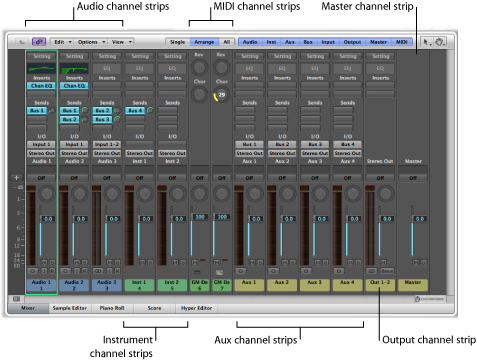Understanding Channel Strip Types in the Mixer
The Mixer displays the following channel strip types:

- Audio channel strips: Control the playback and recording of audio signals on audio tracks. All data on the audio track is automatically routed to the audio channel strip assigned in the Arrange track list.
- Instrument channel strips: Allow you to use and control software instruments. Software instrument plug-ins are inserted into the channel strip’s Instrument slot. The instrument channel strip can then be driven by a recorded MIDI region, or by direct MIDI input—playing your MIDI keyboard. For details about instrument channel strips, see Working with Instruments.
- Aux (Auxiliary) channel strips: Used for a variety of signal routing purposes. They are used to set up send returns, where a channel strip signal is routed to an aux channel strip for effects processing. Aux channel strips are also used for grouping purposes and for distributing a signal to multiple destinations via sends. There are several ways to create aux channel strips. For details, see Creating Aux Channel Strips in the Mixer.
- Output channel strips: Represent the physical audio outputs of your audio interface. These channel strips are used to adjust the overall level and stereo balance—or pan position, in the case of mono output channel strips—of all audio, instrument, or aux channel strips routed into them. The number of available output channel strips is determined by the audio interface in use.
- Master channel strip: A global level control for all output channel strips. The master channel strip changes the gain of all output channel strips without affecting the level relationships between them. This is very helpful as a proportional output volume control and is particularly useful in Logic Pro surround mode where you can use it to create fades in the complete surround mix.
- MIDI channel strips: Control external MIDI tracks. MIDI data on these tracks is routed to a MIDI output port and channel, for control of MIDI sound modules and keyboards. For details, see Working with MIDI Channel Strips in the Mixer.
Note: Additional channel strip types, such as bus and input channel strips, can be created and used. However, their inclusion is primarily for compatibility with projects created in earlier versions of Logic Pro.